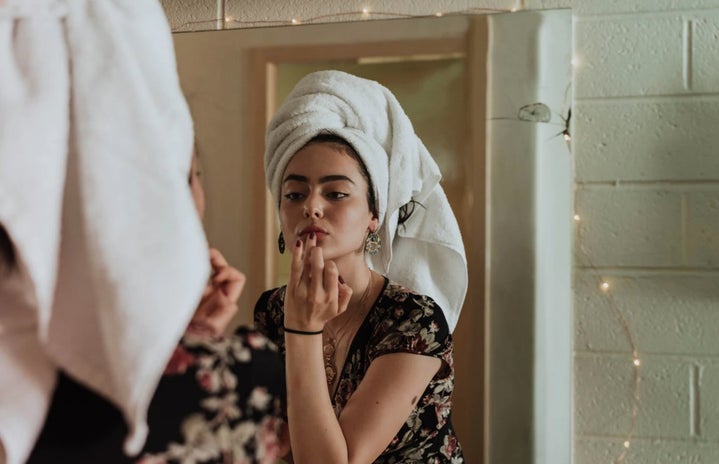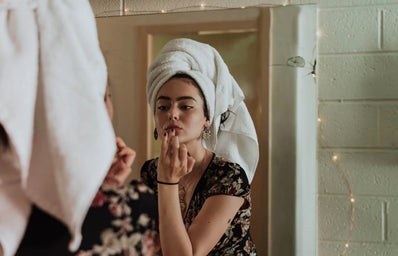Most people get their start in the skincare world for a reason, and it’s often because they are either struggling with acne or they’ve begun to notice the first unwelcome signs of ageing.
For me, it was the latter. I spied some pesky little lines on my forehead last summer and thought — “How could this be happening? I’m only 22!”
And maybe that’s the problem. Most of us wait for a reason to take care of our skin. In our pursuit of a healthy lifestyle, we often completely forget that skincare is still an important facet of bodily health and self-care.
When I learned about the reasons behind my fine lines, I discovered it wasn’t simply because I have a dry skin type and I wasn’t drinking enough water (especially on nights out with friends). There were also many more objects in play which, had I known about them earlier, could’ve prevented the damage to my skin.
As I started to read up about skincare and personal health, I began to share the things I learned with my friends. I then discovered that quite a lot of them didn’t seem to hold a connection between skincare and health at all, nor did any of them have skincare routines of their own.
My friends are pretty health-conscious, but when they think about physical health (like lots of people) they think about matters generally relating to diet and exercise. You know, things that require rigorous routines and lots of personal discipline — but little did they know that skincare works exactly the same way!
There is this misconception that skincare is a matter exclusive only to those who struggle with acne or to middle-aged women who want to “look young again” but this is very false and also a big reason why young people go about their lives thinking their skin is impervious to damage and I was certainly no exception.
The fact is, your skin is the largest organ in your body and it requires some degree of maintenance and care too. If you are health-conscious, it is fair to assume you should want to care for every part of your body. We all have skin and that means we all need a basic routine. This applies to women and men, as well as everyone in between.
But how can you begin to build a basic skincare routine? There are dozens of options and dozens of products that all seem to generate more confusion than seems worth it. You might find yourself asking things like, “What’s the double cleanse method?” “What’s the difference between UVA and UVB rays?” “Do I really need a full 7-step to 10-step skincare routine?”
It is definitely a long process that requires a lot of research, but I’m here to tell you that learning about skincare and building a routine doesn’t have to be complicated! But before getting into the four basic steps of a routine, you must first familiarize yourself with some… well, let’s just call them ground rules.
Before you get started
When we buy things at the store, we are normally occupied with all the pomp and circumstance at the front of the package and not the fine print in the back.
This is a mistake.
It is very important that you check the back of your product for the actual ingredients, as you will soon come to learn that not all skincare ingredients are as good for you as they may seem, and a lot of marketing on the front can actually be misleading!
The first thing you need to know is that the first ingredient makes up the largest portion of the formula while the last ingredient makes up the least. This makes it a lot easier for you to learn what’s beneficial — and what to avoid. Generally, it’s usually best to give a wide berth to things like coconut oil (which clogs pores), sulfates (which strips the moisture barrier), and most of all, fragrance (which irritates the skin).
Other products that are also considered big no-nos include pore strips, peel-off masks, and harsh physical scrubs that use harmful ingredients such as walnuts to exfoliate the skin. Try your best to keep things basic as you start to build your basic four-step skincare routine.
- Step 1: Cleansing
-
First thing’s first: Do you use makeup wipes? If yes, do yourself a favour and toss them out now. Yes, right now, go!
Using cleansing wipes to remove a full face of makeup is very frowned upon for its harsh tugging of your skin while being wholly ineffective at proper makeup removal — they are also very wasteful!
Instead, let’s learn about proper cleansing (and no, soap isn’t acceptable either, but bear with me as I explain).
Washing your face is something you need to do every day both morning and night, especially if you are someone with oily skin. Gunk and sweat build up on your face both as you sleep and while roaming about outside, and it all needs to get rinsed off before it starts to show results on your face.
If you have dry skin, your morning wash should start with a gentle and hydrating non-foaming cleanser, as that will preserve your moisture barrier without stripping your skin. If your skin is excessively dry, however, you can skip the cleanser and start with a cleansing toner instead (which we’ll get into later!).
If you have oily skin, a foaming cleanser would be perfect for you. If you struggle with acne, you could even benefit from using an SA (salicylic acid) cleanser, which will have an extra punch to it as it seeps into your pores and cleans out your skin!
Your night wash will look a little different, as it involves what’s called a double-cleanse with either a balm or an oil. If you don’t wear makeup, you will still need this step to properly remove your sunscreen, as most are too heavy to be properly removed by a regular cleanser.
Now if you do wear makeup, you might think a double cleanse will unnecessarily draw out the removal process when you’re tired and just want to go to bed, but you might be surprised to know it’s actually much faster (and much better) than using makeup wipes!
Before I personally got into double cleansing, I always used to wake up with smudged traces of mascara still left under my eyes when I thought it had all been successfully washed off. After switching to a balm, however, there’s been no residue in sight!
All you need to do is massage the oil or balm into your dry skin and it will instantly start melting down the most stubborn of makeup without any harsh tugging whatsoever. Once everything is melted down, you can wash it all off with your regular cleanser and voila! A perfect, effortless cleanse!
- Step 2: Treatments
-
This step is very customizable based on you and your skincare needs. It can involve a whole range of products that add an extra ‘oomph’ to your routine. You can add toners, which can be exfoliating, hydrating, or cleansing, and will help your other products absorb into your skin. You can add serums, which are concentrated forms of ingredients that pack a strong punch. You even have a whole range of masks that can purify, hydrate, and more!
Simply take a look at your skin and see what problems you may have.
Are you struggling with an overproduction of sebum that results in oily skin? Try a niacinamide serum! It is a very stable active ingredient that works wonders for sebum control and flare-ups on your skin and is also great for reducing acne scars.
Is your skin dehydrated and looking parched? Try a hydrating toner and/or a sheet mask, and it should plump right up! These products will usually contain humectants such as hyaluronic acid and glycerin, which will draw moisture right back into your skin and give it back its dewy shine.
Starting to see signs of ageing on your sin? Consider using a retinol serum! It is backed up with heaps of research and has been proven to speed up your skin’s cell turnover rate (the frequency with which your skin can produce fresh new cells) so that it reduces signs of ageing and makes you look good as new!
One thing to remember as you experiment with this step is not to layer too many treatments. Overapplying actives could stress out your skin and cause irritation and/or breakouts, so take it slow and cycle through two or three products between your morning and night routine. This way you can learn what your skin needs over time, and eventually, get a sense of what works and what doesn’t!
- Step 3: Moisturizing
-
This should really go without saying — your skin needs moisture. It locks in your treatments and adds some much needed TLC that will last you for the rest of the day and throughout the night.
If you have dry skin, a moisturizer will definitely be your best friend, especially during the harsh winter months. It creates a protective barrier from the environment in the morning and does reparative work while you sleep. Look for occlusive ingredients such as shea butter or cocoa butter and your skin will thank you for the love!
People with oily skin tend to be wary of moisturizers as they worry it might exacerbate the oiliness of their skin, but there is nothing to fear. You can find plenty of lightweight water-based moisturizers that will absorb super lightly into your skin while adding some much-needed hydration.
And here’s a little industry secret: Your moisturizer can even double as an eye cream. They are equally as effective and don’t cost nearly as much, so it’s an easy way for you to save money while still seeing the same results.
- Step 4: Sunscreen
-
This is the most important step in your routine. If you want healthy unblemished skin, you absolutely cannot neglect this step.
You might be under the impression that sunscreen is only necessary for days on the beach where you want to avoid getting sunburnt, and if so… you’d be partially right.
The sun emits two kinds of ultraviolet rays: UVA and UVB. UVB rays are the ones responsible for the darkening of your skin and those angry red burns you in the summer, and they are what we typically associate with sunscreen use. However, UVA rays are just as responsible for skin damage and are much harder to avoid — they are still present on cloudy days and even in the safety of your bedroom.
It is estimated that 90% of skin ageing is caused by the sun alone, and it is a big reason why you will develop forehead lines by your mid-twenties along with a bunch of random sunspots popping up on your skin. It might bring sunshine and vitamin D into your life but make no mistake — the sun is not your friend and it certainly wasn’t mine.
To combat the effects of the sun you must always, always wear sunscreen with an SPF between 30 to 50. Anything lower won’t be effective, and anything higher is a marketing ploy. You can choose between either a mineral sunscreen or a chemical one, but know that the chemical one will take 15 minutes to go into effect as it sinks into your skin while the mineral one will protect you instantly as it sits over your skin.
When applying your sunscreen, always make sure to have a two-finger width worth of sunscreen and pat it on — avoid rubbing as this can lessen the effectiveness of the sunscreen. If you’re worried about an excessive white cast (which is especially hard to avoid with North American sunscreens) I suggest looking into Korean sunscreens! Their ingredients are much more innovative, don’t leave any cast at all, and are chock full of advanced sun-protective ingredients that aren’t even available on our side of the world!
Bonus step: Have fun with it!
Skincare might seem like an intimidating world to venture into at first, but it’s starting to catch a lot of momentum among young people who are learning to enjoy it! With resources like Hyram and Mixed Makeup on Youtube, you can learn all about the wonderful world of skincare and maybe even be confident enough to start adding a few extra steps to your routine!
You certainly don’t need to spend a fortune on your skincare to have an effective collection of products either. Brands like The Ordinary, CeraVe, and The Inkey List are all fantastically affordable while delivering its users the best results possible. If you ever do feel like treating yourself to a fancy mist or two though, no one’s judging you!
Remember that this is supposed to be a mode of self-care and you can do whatever makes you happy — as long as it doesn’t damage your skin. Take pride in it and commit to your morning and nightly skincare routines and I promise your effort won’t go unnoticed. The earlier you start, the better condition your skin will be in as you move forward in your life.
I may have taken some damage myself, but adopting a good skincare routine has been a great way to reverse the effects I’ve sustained so far! In fact, after a few months of committing to my routine, my brother came up to me and said my skin actually looked different — glowy.
He quickly followed it by saying I was still ugly, but hey… small victories are still victories.



